

Blended Learning Helps Students at Different Cognitive Levels. What is the best way to meet today’s students “in the middle?”
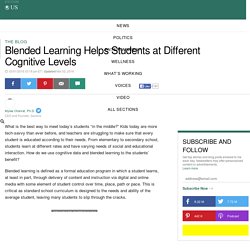
Kids today are more tech-savvy than ever before, and teachers are struggling to make sure that every student is educated according to their needs. From elementary to secondary school, students learn at different rates and have varying needs of social and educational interaction. How do we use cognitive data and blended learning to the students’ benefit? Blended learning is defined as a formal education program in which a student learns, at least in part, through delivery of content and instruction via digital and online media with some element of student control over time, place, path or pace.
This is critical as standard school curriculum is designed to the needs and ability of the average student, leaving many students to slip through the cracks. The Face-To-Face Driver Model The face-to-face driver model incorporates most elements of traditional teaching with some online augmentation. The Global Search for Education: Just Imagine - Dr. Brian Annan - New Zealand. “We created an image of a teacher and students in a class with digital tools from which they can access families, the community, the environment and the world at large through the internet.” — Brian Annan Just Imagine schools decades from today - what will they be like?
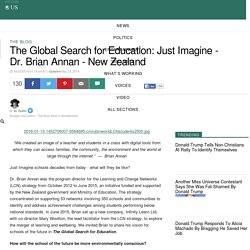
Dr. Brian Annan was the program director for the Learning and Change Networks (LCN) strategy from October 2012 to June 2015, an initiative funded and supported by the New Zealand government and Ministry of Education. The strategy concentrated on supporting 53 networks involving 350 schools and communities to identify and address achievement challenges among students performing below national standards. In June 2015, Brian set up a new company, Infinity Learn Ltd, with co-director Mary Wootton, the lead facilitator from the LCN strategy, to explore the merger of learning and wellbeing. How will the school of the future be more environmentally conscious? How will the school of the future be more globally inclusive?
C. C. Blended Learning and the Flipped Classroom » Center for Instructional Technology & Training » University of Florida. Overview What is Blended Learning?
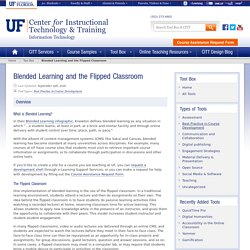
In their Blended Learning infographic, Knewton defines blended learning as any situation in which “…a student learns, at least in part, at a brick-and-mortar facility and through online delivery with student control over time, place, path, or pace.” With the advent of content management systems (CMS) like Sakai and Canvas, blended learning has become standard at many universities across disciplines. For example, many courses at UF have course sites that students must visit to retrieve important course information or assignments, or to collaborate through participation in discussions and other online tools. If you’d like to create a site for a course you are teaching at UF, you can request a development shell through e-Learning Support Services, or you can make a request for help with development by filling out the Course Assistance Request Form.
The Flipped Classroom. What is Flipped Classroom?: Essentials of Blended Learning Course Design. When a classroom is "flipped" the delivery of instruction happens outside of the actual class meetings.
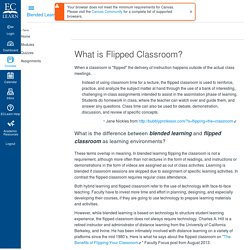
Instead of using classroom time for a lecture, the flipped classroom is used to reinforce, practice, and analyze the subject matter at hand through the use of a bank of interesting, challenging in-class assignments intended to assist in the assimilation phase of learning. Students do homework in class, where the teacher can watch over and guide them, and answer any questions. Class time can also be used for debate, demonstration, discussion, and review of specific concepts. ~ Jane Nickles from (Links to an external site.)
Blended and flipped specialreport. Flipped Teaching and Learning – A Form of Blended Learning That Just Makes Sense – Flipped Classroom Workshop. Flipped Teaching incorporates elements of online learning and traditional learning, more commonly referred to as Blended Learning.
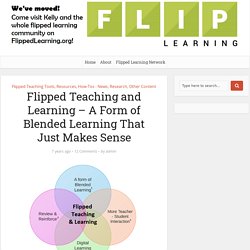
Blended Learning has been shown in multiple studies to be the optimal method of teaching (in contrast to exclusively online or face-to-face formats). Here are a few resources for further exploration: Is Blended Learning Most Effective? , Blended Learning from the EDUCAUSE Center for Applied Research.The combination of digital learning materials and increased classroom time both provide more opportunities for the review and reinforcement of learning materials (and how can that be a bad thing?). One of the fundamental advantages of the flipped classroom is the increased time teachers to get spend with students, providing personalized and differentiated instruction, and pursuing other teaching methods such as Active Learning (learn more about how the flip facilitates Active Learning in this article).
‘Nuff said? Venn Diagram made with Lucid Chart for free! What is Blended Learning? Blended courses (also known as hybrid or mixed-mode courses) are classes where a portion of the traditional face-to-face instruction is replaced by web-based online learning.
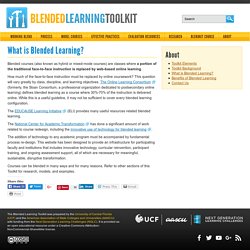
How much of the face-to-face instruction must be replaced by online coursework? This question will vary greatly by class, discipline, and learning objectives. The Online Learning Consortium (formerly, the Sloan Consortium, a professional organization dedicated to postsecondary online learning) defines blended learning as a course where 30%-70% of the instruction is delivered online. While this is a useful guideline, it may not be sufficient to cover every blended learning configuration. The EDUCAUSE Learning Initiative (ELI) provides many useful resources related blended learning.
Blended Learning Toolkit. What’s the Difference Between a Flipped Classroom and Flipped Learning? "If only [insert subject here] were taught this way when I was in school, I might actually know how to do it.
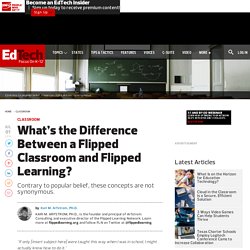
" I have said this countless times, and I hear it often from others. As executive director of the Flipped Learning Network (FLN), I have an "elevator speech" at the ready whenever people ask what flipped learning is. Once I explain the concept — and they register how a flipped classroom could have changed their own learning experience — they nearly always respond with some variation of that refrain.
Defining the Terms Usually, the quick explanation I offer describes a flipped classroom: In this scenario, teachers record their lectures, which students watch outside of class, and then dedicate class time to doing the homework. 20 - Blended or Flipped Classrooms. Blended Learning vs Flipped Learning: Can You Tell The Difference? - eLearning Industry. Blended Learning, Flipped Classroom - What's the Difference? Over the past twenty years, advances in the areas of web and video content delivery have aided the growth of technology-based teaching methodologies, including the flipped class model, blended learning, MOOCs, and more.
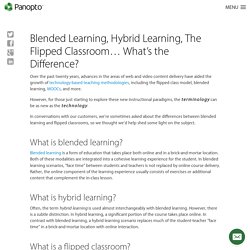
However, for those just starting to explore these new instructional paradigms, the terminology can be as new as the technology. In conversations with our customers, we’re sometimes asked about the differences between blended learning and flipped classrooms, so we thought we’d help shed some light on the subject. E-learning: tudo o que você precisa para o seu EAD - Edools. Um e-learning é uma modalidade de educação através da qual se faz necessário o uso de um ambiente virtual de aprendizagem, na maioria das vezes disponibilizada através de uma plataforma e-learning.
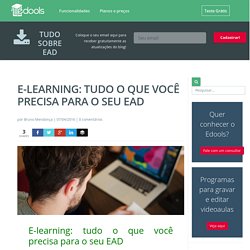
Logo, o e-learning é caracterizado pelo distanciamento físico entre aluno e professor, mas havendo sempre uma flexibilidade de tempo e espaço, visto que ambos os envolvidos podem interagir entre si a qualquer momento e de qualquer lugar que tenha acesso à Internet. O e-learning é um processo relativamente novo. No entanto, o mesmo vem tendo um crescimento extremamente acelerado a partir do grande aumento da demanda por cursos online e de treinamentos corporativos, este último incentivado através da educação corporativa nas empresas. Hoje podemos dizer o que e-learning já é uma realidade no país e tem tudo para crescer ainda mais com o passar do tempo, visto que os seus benefícios e vantagens estão cada vez mais de acordo com a nova realidade da educação e com o novo perfil de alunos existente. Blended Learning Definitions.